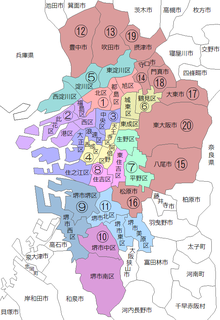This article has multiple issues. Please help improve it or discuss these issues on the talk page. (Learn how and when to remove these messages)
|

The Osaka Metropolis Plan (大阪都構想, Ōsaka-to kōsō) or Osaka Metropolis was a plan to transform Osaka Prefecture from a fu, an urban prefecture, into a to, a metropolis. Under the initially envisioned plan, Osaka city, Sakai city, and other surrounding cities in Osaka prefecture, were to be dissolved and – similarly to the special wards of Tokyo – subdivided into special wards which had a status as municipalities but left some municipal tasks and revenues to the prefectural administration. As political resistance grew, notably the opposition to the plan in Sakai City expressed in the 2013 mayoral election, the concrete plan was reduced to, at least as a first step, only abolishing Osaka City. As in Tokyo, the metropolis would have continued to include all other municipalities of the prefecture and served as a prefectural government for them.
The plan was defeated by a slim margin of 0.76% in the 2015 Osaka Metropolis Plan referendum in Osaka City.
After the April 2019 unified local elections and the June 2019 Sakai City mayoral election, the ORA regained the governorship and a majority in the assembly, the mayorships of Osaka City and Sakai City, and strong pluralities in both city assemblies. Other parties have indicated to allow for a second metropolis plan referendum.[1]
On November 1, 2020, a second referendum to merge Osaka's 24 wards into 4 semi-autonomous wards was narrowly voted down. There were 692,996 (50.6%) votes against and 675,829 (49.4%) votes supported it.[2] Osaka mayor and Osaka Ishin co-leader Ichiro Matsui said he would resign when his term ended in 2023.[2]
- ^ The Mainichi, June 15, 2019: LDP turns around on Osaka metropolis plan, OKs referendum, retrieved June 19, 2019.
- ^ a b Eric Johnston (November 2, 2020). "Osaka referendum defeat raises questions about future of city's politics". Archived from the original on November 2, 2020.